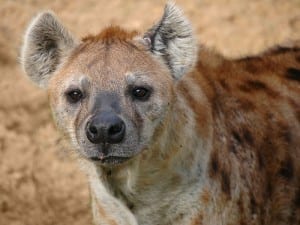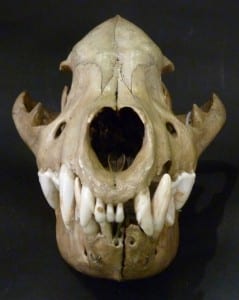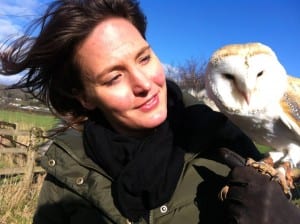Animals and their super senses
By Dean W Veall, on 26 August 2014
Guest blogger Dr. Helen Czerski
Peering up the nose of a hyena is not generally on the “to do” list of most people. As a physicist it’s also not the sort of thing you are trained to do, either. Fortunately for me, this hyena was long-dead – I was only faced with a skull that had just been borrowed from its display case in the Grant Museum of Zoology. And its nose was well-worth ogling.
During the last eight months, I’ve been filming a new series on the science of animal senses for BBC2, Super Senses, The Secret Power of Animals which started last Tuesday at 9pm. It’s been a fascinating journey, and it’s really made me think about how animals sense the world. It’s often not the case that their senses are just like ours but better. Some of them use completely different mechanisms for sensing. We physicists are used to thinking about detectors – it’s how we measure the physical world. And all humans have detectors built into our own bodies. They’re our eyes, ears, nose, tongue, touch sensors, temperature sensors and more. They’re constructed from cells rather than metal and plastic, but they’re still detectors.
The first problem for any living thing is to know something about what’s going on in its environment, so that it can respond and give itself a better chance of survival. All of us are constantly bathed in information – light waves, sound waves, scent molecules in the air, pressure changes and so on. But our human senses only tap into a small part of that, and we’re blind to the rest. There are plenty of animals out there that need some of the other information, and they have evolved different senses. They have effectively solved the engineering problem of “how can you measure that?”. And they’re not the only ones who need to know. Maybe those solutions could inspire human engineering as well. Why re-invent the wheel, if nature has already done the job for you?
As scientists work out how animals do things, engineers are starting to ask what else those ideas could be useful for. Standing in the Grant Museum, I was surrounded by animal specimens, and also surrounded by a cornucopia of solutions to the problem of survival.

Spotted hyena (Crocuta crocuta)
Image taken by Marieke Kuijpers obtained from http://commons.wikimedia.org
The hyena nose is an answer to the question “how can I sense the tiniest quantities of a scent that might lead me to dinner?”. When you look up the nose of a hyena skull, you can see a honeycomb structure about the size of a large marble. It’s made of tiny thin platelets, and together they have a huge surface area. As the hyena sniffs air in, the air travels over those platelets, and over the huge number of odour detectors that can fit on their surfaces. The more detectors there are, the better the chance that an odour molecule will come to rest on one. So the hyena can sift the breeze for information, pick up on tiny chemical clues and use that information to find dinner.
Standing in the museum, I was mostly just glad that I didn’t have to meet a living hyena to admire its nose. But the last few months have made me think differently about the fascinating variety in the animal kingdom. It’s not just variety of form, but variety of function. Each of those structures evolved to solve a problem. What can we learn from their solutions?
Join me and other UCL Engineers for our event Animals and Engineers event we share some of our amazing engineering research inspired by the natural world and discuss the making of Super Senses: The Super Power of Animals. Wednesday 3rd September at 6.30pm in the Darwin Lecture Theatre here at UCL.
Dr. Helen Czerski is a Research Fellow at UCL’s Department for Mechanical Engineering.
 Close
Close



